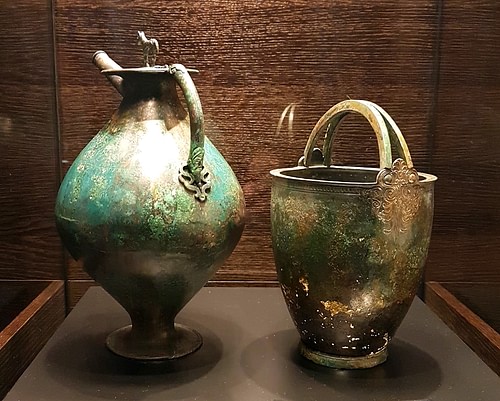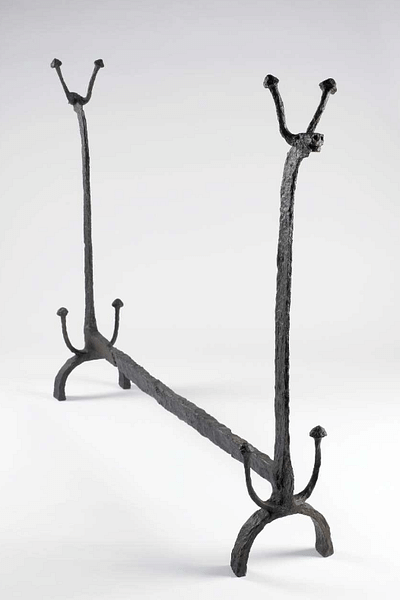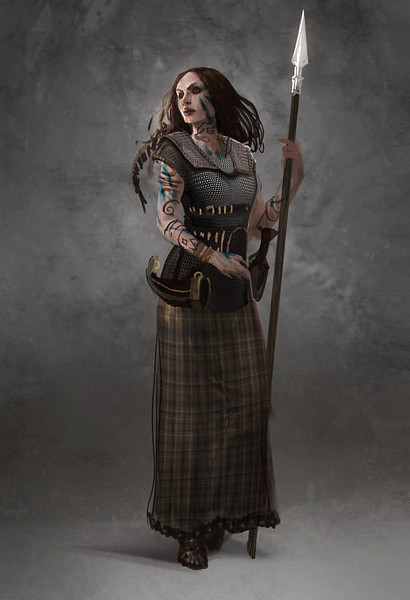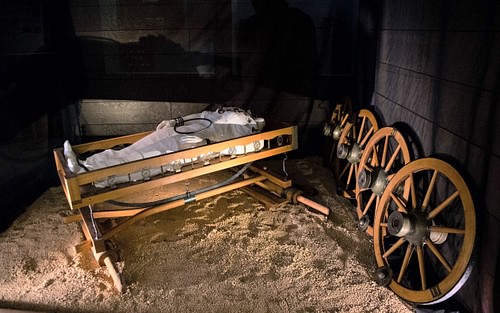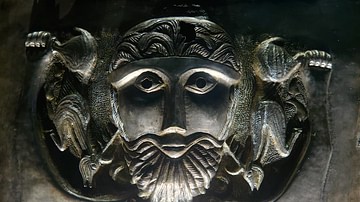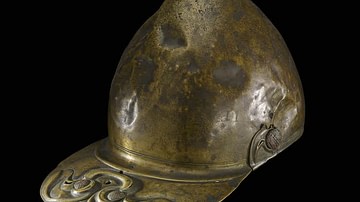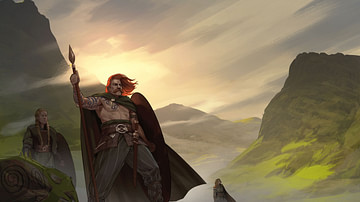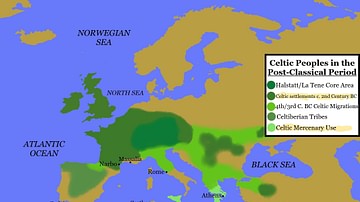The society of the Celts in Iron Age Europe was made up of several distinct hierarchical groups. At the top were rulers and elite warriors, then there were the religious leaders, the druids, and then specialised craftworkers, traders, farmers, and slaves. Our knowledge of Celtic society is, unfortunately, fragmentary and reliant on secondhand literary sources and archaeology. Nevertheless, there are many features of Celtic society that we do know about, whether it be the status symbols of ancient Gauls or the fighting queens of ancient Britain.
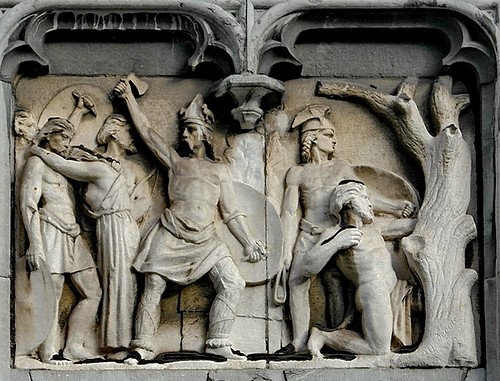
The Constituents of Celtic Society
The Celts have left no extensive written records of their own and so we are obliged to study secondhand accounts by classical authors and piece together features of society from archaeological remains. We do know that most Celtic communities were rural and agrarian with a distinct hierarchy, at the top of which were kings or queens or an aristocratic group, and their kinsfolk whose wealth was based on land ownership. Below these were various groups divided by function and skills such as warriors, druids, specialist artisans and traders (including foreigners). The vast majority of the population were low-skilled craftworkers and farmers; at the very bottom of society were the slaves. Except for slaves, there is no evidence of any barriers for the child of one of these groups to eventually enter another group provided they acquired the necessary wealth (through valour in war, for example) or went through the required education or apprenticeship.
Within Celtic society there was a binding system where powerful individuals undertook to look after others - that is provide food, shelter, legal and military protection - in return for some sort of service, much like in the lord and vassal relationship of medieval feudalism. For the Celts, such a person was an ambactus, and the result was ties of loyalty were established to their lord and the wider ruling class and status quo. Some lords commanded the loyalty of thousands of kinsmen, retainers, and vassals. However, these are generalisations, and as with other areas of Celtic culture, it is important to stress that there were great variations both as the Iron Age period developed in Europe and in terms of geography. In short, Celtic societies in one part of Europe in 700 BCE were perhaps very different from those in another part of the continent, never mind compared to Celtic societies in 400 CE.
Rulers
Celtic communities were divided into tribes led by a monarch or a small aristocratic group. Some tribes, such as those in modern Belgium, may have had two monarchs ruling at the same time. Over time, this system of monarchy gave way to a more complex government consisting of confederations of tribal chiefs and individual tribes run by councils of elders. So, too, some tribes became the clients of more dominant tribes and so were obliged to make payments of goods or provide hostages (typically young men to perform as vassals). This web of alliances in Gaul and elsewhere was further complicated when the Romans took a greater interest in expanding their empire and previously disadvantaged tribes sided with the invaders to further their own causes against traditional tribal enemies.
Rulers and tribal leaders were expected to give gifts to their followers and, coming largely from war booty, these were distributed according to rank in the community. Leaders also had to provide feasts. At these events, social status was attached to the seating arrangements, as commented on by the Greek author Poseidonius (c. 135-51 BCE) in his Histories:
…they sit in a circle with the most influential man in the centre whether he be the greatest in warlike skill, nobility of family or wealth. Beside him sits the host and on either side of them the others in order of distinction.
(quoted in Allen, 16)
The tableware was another area to show off social status, especially the drinking cups, vessels for serving wine, and cauldrons for serving food. Many of these items were imported from neighbouring cultures and so a host could show off their wealth and the superior craftsmanship of these rare and exotic wares. The use of these objects was sometimes prescribed by the social status of the attendees. Some tankards, for example, were designed for communal drinking where the order of drinkers would have been well-defined. Even the food itself was part of the social display as only the most senior guests were allowed the best cuts of meat, for example. The best meat of all was a piece cut from the thigh and was reserved for the greatest warrior present. If another warrior felt that he was superior, he could claim this piece of meat for himself and so challenge the leader to a fight.
Even in death, Celtic rulers were given great respect. Graves of the Celtic elite frequently have a range of particularly well-made, costly, and rare goods buried with the dead, a case perhaps of conspicuous consumption and designed to show the wealth and power of the deceased and, more importantly, those who honoured their passing and possibly inherited their title and power. Indeed, kinship was an integral part of Celtic society as extended families were formed that could trace their lineage back to a single ancestor.
Warriors
That warriors enjoyed a high status in Celtic society is suggested by the number of gods in the ancient Celtic pantheon associated with war and the great quantity of weapons and armour found in tombs. Courage and prowess in battle were greatly esteemed.
Celtic warriors in Gaul are described as bleaching their long hair using lime-water while in Britain, they painted designs on their bodies. Several classical authors also comment on the strange fact that Celtic warriors could enter battle naked. All of these habits suggest, above all, that warriors were keen to identify themselves as part of the same social group. Many Celtic warriors wore a torc necklace - the famous Dying Gaul statue of the Capitoline Museums in Rome wears one - and these were likely a symbol of status and rank within the community.
Another very visible indicator of status was the use of highly decorated armour, shields and weapons. Only the wealthiest of warriors could afford such items decorated with precious materials like gold, silver, ivory, semi-precious stones, enamel, and pieces of coloured glass. So, too, only the wealthy could own chariots, horses, and employ attendants for assistance in battle - the number of these became a matter of prestige for the elite. Yet another mark of distinction of the warrior elite was noted by Poseidonius: "the nobles shave the cheeks but let the moustache grow freely so that it covers the mouth" (quoted in Cunliffe, 234). Finally, family history and lineage were important, and Celtic warriors were fond of proclaiming these before their enemies just prior to battle.
Druids
The religious leaders of Celtic communities were the druids who were regarded as intermediaries between humanity and the gods. As Julius Caesar (c. 100-44 BCE) noted:
The Druids officiate at the worship of the gods, regulate at public and private sacrifice, and rule on all religious questions. Large numbers of young men flock to them for instruction, and they are held in great honour by the people.
(Gallic Wars, VI:13)
The high status of druids in Celtic society is evidenced in their exemption from military duties and taxes. Druids may have emphasised their elevated status by wearing distinctive long white robes and perhaps, too, unusual headgear with horn or antler attachments. Although Caesar mentions a chief druid being elected for one year in Gaul, it is not known if any other levels of hierarchy existed amongst the druids themselves.
Known for their great wisdom and knowledge of traditions, druids were repositories of the community's history, and this they passed on to novices who spent some 20 years acquiring the skills and know-how of druidism. Instruction was done orally, and this may have reflected a desire to keep the druids' knowledge exclusive to the initiated rather than because of a lack of literacy. Druids gave counsel to rulers, presided over courts of justice, deliberated on community conflicts, and made medicinal potions. They may also have been required to cast taboos (or, less accurately, spells) on people, ensuring compliance to the society's rules. These rules could be quite mundane such as not eating the meat of a particular animal but failure to obey them led to exclusion from the community’s religious ceremonies. Not being able to participate in rituals made that person unclean and an outsider within the community.

The druids were so important to Celtic society that the Romans eventually considered them enemies of the state. It is perhaps no coincidence that the regions which most strongly resisted Roman control were also noted centres for druids. Several Roman emperors made attempts to eradicate the druids altogether, notably, Tiberius (r. 14-37 CE) and Claudius (r. 41-54 CE). In 59 CE, the druid centre on Anglesey, Wales was systematically attacked by a Roman army and druidism was banned.
Seers, Bards & Craftworkers
A figure similar to a druid was the seer who divined future events by interpreting natural phenomena or such things as flights of particular birds and the entrails of sacrificed animals (and humans). These figures are called the vates by the Greek writer Strabo (c. 64 BCE - 24 CE). A third figure, seen in Ireland, was the fili or learned poet-historian. Besides composing eulogies and invectives, the fili also passed on orally to the next generation the folklore of the community and they were involved in some way with law codes and prophecy. Whether druids, seers, and fili were entirely separate individuals or could be found in a single individual is still much debated by scholars. There, was, too, another figure involved in justice mentioned by Julius Caesar. This is the Vergobretus who was elected by the aristocracy for one year and who served as the highest magistrate with absolute power over all in terms of the application of the law.
Bards, with their storytelling, poetry, and skill playing the harp were greatly esteemed in Celtic culture, although the ancient Celts ranked them below the druids and vates in social status. In Ireland, the bards had a lower social status than the fili. The bards did no harm to their reputation by singing the praises of men of high status at Celtic feasts.
Although craftworkers and skilled artisans such as carpenters, potters, and weavers were essential to everyday life, we know very little about those in Celtic societies. The one group we do know something of is blacksmiths. Smiths were essential to work iron, which needs a high level of technical skills to work compared to some other metals. Iron was used for such essential items as agricultural tools, weapons, and cooking implements. Not surprisingly for a worker who transformed metal with fire, smiths feature in Celtic mythology, and certain gods were given forging and metalworking skills like Goibniu in medieval Irish mythology, who was based on an earlier ancient Celtic god of smiths of unknown name. In Gaelic Scotland, smiths were credited with healing powers, and all they needed to do was hold their hammer over the sufferer.
Women
The number of female goddesses and their role would suggest that Celtic women enjoyed a better social status than in some other contemporary cultures but, unfortunately, there is very little direct evidence for the role of women in ancient Celtic society.
River sources were particularly important in the Celtic religion, and many of these were given female personifications. For example, Sequana was associated with the River Seine and with healing. The goddess had an important sanctuary at the source of the Seine near Dijon where many votive offerings were dedicated to her; the goddess' temple there was still going strong well into the Roman period. It is a curious distinction between the Celtic and Mediterranean cultures that in the former, many female gods were associated with healing while in the latter it was male gods like Apollo and Asclepius.
That women could rule in their own right is evidenced by two cases in Britain. The first is Cartimandua, ruler of the Brigantes tribe in the north of England. In the mid-1st century CE Cartimandua is recorded as giving up a fugitive Celtic prince to the Roman authorities. The second case is Boudicca, queen of the Iceni tribe, who led a revolt of several tribes against the Roman occupation in 60 CE. Initially successful and capturing Roman London and Colchester amongst other strongholds, the revolt was quashed, and Boudicca either committed suicide or died of disease in 61 CE.
Boudicca led her army in person, and there were perhaps women warriors in some Celtic armies, although ancient writers give them little notice. Certainly, the Celtic gods included women such as the Irish-Celtic trio of war goddesses known as the Mórrigna: Badb, Macha, and the Mórrigan. In addition, in Irish medieval mythology, several male heroes, notably Cú Chulainn learnt to use weapons from female masters such as Scáthach and Aife, suggesting a long tradition of a strong female role in Celtic warfare.
Evidence that women were druids in antiquity is scarce, but there is no evidence they were prohibited from the role. Reference to women as druids comes from sources in late antiquity or the medieval period, and then they are referred to only in Gaul and Ireland. However, as the historian Chiara Tommasi notes, these sources "are of doubtful reliability and should probably be dismissed" (Bagnall, 2329).
Another indicator of women’s status is burial sites. The Vix Burial near Châtillon-sur-Seine in northeast France dates to the late 6th or early 5th century BCE, and it shows that some Celtic women were given just as much respect and attention in their burial as men. The deceased was a female aged around 35, and she was placed on a four-wheeled waggon. The riches buried with her include a massive bronze krater imported from the Mediterranean, a large gold neck torc, a necklace of amber from the Baltic, bronze and lignite bracelets, and a brooch with exotic coral decoration. All of these items together illustrate that whoever this woman was, the ancient Celts were prepared to dedicate a great deal of time and wealth to her burial, suggesting she was a person of significant importance in the community in which she had lived.
For more ordinary women, information is scarce and not perhaps entirely reliable. Classical authors, who likely did not fully understand the foreign customs they came across, noted that Celtic women were beautiful and as tall and courageous as Celtic men. It is noted that Celtic women are promiscuous and wives are shared between the male relatives of the husband. Julius Caesar observed that Celtic women in Gaul brought to their husbands a dowry and that this could be inherited by the woman if her partner died before her. The Roman general also noted that husbands had the power of life and death over their wives and their children. Women were often married into different tribes to cement alliances and create lasting bonds between them.
Children
According to Julius Caesar, children in Gaul were supervised by their fathers, although there was some sort of taboo for a boy who had not yet reached maturity to sit in public with his father. This comment by Caesar is perhaps really connected to the practice that some children may have been given to foster parents to increase ties between families and improve the child’s prospects by having them brought up by aristocratic parents. This was certainly the case in medieval Ireland, but whether the practice had died out in ancient Celtic society by Caesar’s time is still not agreed upon by scholars. Another type of fostering was to take the children of newly conquered tribes as hostages and bring them up in the families of the conquerors. This ensured the compliance of leading conquered families and helped bond the two tribes in future generations.
It is curious that archaeological excavations of Celtic sites have found relatively few children’s graves, and this may be explained by a lack of formal burial. Childhood likely ended around the age of 14 for both boys and girls. Boys now swore allegiance to an elder male in the client system mentioned above while girls were now deemed of marriageable age.
Foreigners & Slaves
Foreign traders and craftworkers seem to have been welcomed in Celtic communities. Detailed analysis of human remains has revealed that not a few individuals in one burial site were born hundreds of miles away. The evolution of Celtic art pieces like fine brooches and torcs also strongly suggests foreign craftworkers relocated and brought with them new skills such as granulation and enamelling.
Slaves were the lowest class in Celtic communities and were both men and women. Slaves were used in Celtic society and as an item for trade, in the latter case the source being those captured in warfare or people who could not pay their debts. Interestingly, the Celtic word for a female slave - cumal - came to be used as a term for a unit of currency.

